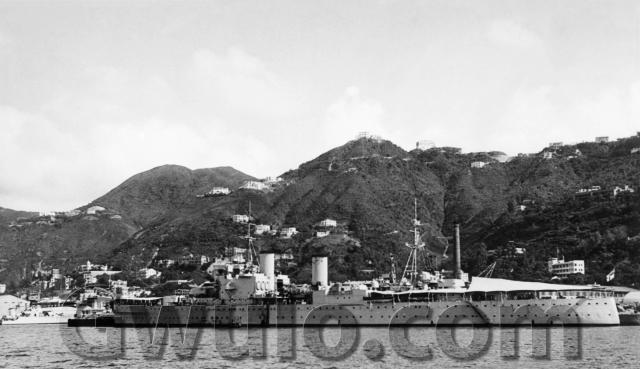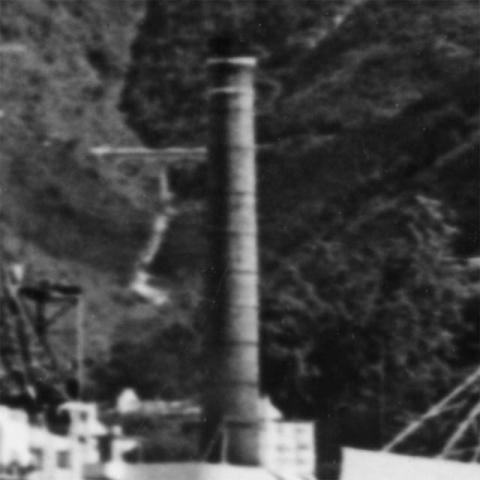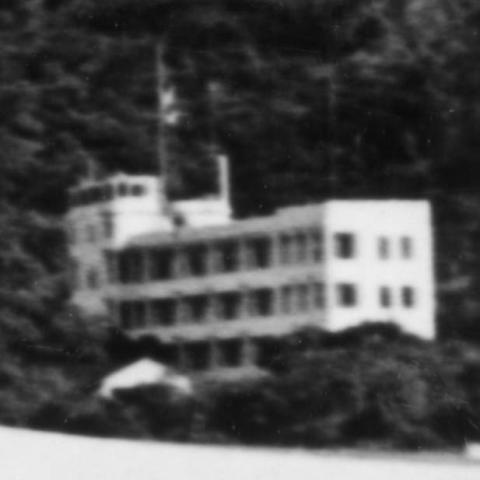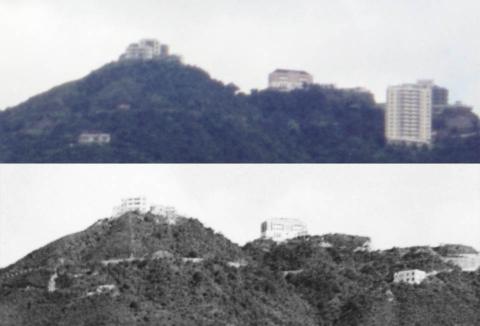[Update, 22 May 2012: If you read the comments below you'll see the ship has been identified as HMS London, and the date around 1948/9.]
What: I'm hoping one of our nautical readers can tell us which ship this is.
Where: Behind the ship is the big chimney that we've seen before [1]. It was attached to the Naval dockyard's power station.
The ship was moored across the front of the dockyard's dry dock. Today the PLA's Central Barracks are on the site of the old dry dock, so if you imagine the wall along the northern edge of those barracks, that's about the ship's location.
Over on the left of the photo is the entrance to the old tidal basin. That's now the site of the new Central Government Complex.
Who: We're not close enough to see anyone, but if we could they'd be sailors!
When: I've guessed it's in the 1930s, but it's not a very confident guess.
One clue is a relatively modern building in the lower-right corner of the photo:
It's further back, and a little way up the hill. That puts it out of the Navy's land and over in the Army's Victoria Barracks. I think it was the Army's headquarters building, built in the 1930s. Can anyone confirm?
It's also interesting to compare the skyline with a later photo taken around 1968-9 [2].
Similar photos taken immediately after WW2 show the Japanese War Memorial [3] on the left hilltop, and an empty space where the building in the centre stands.
So either this black & white photo was also taken post-war (and post-demolition of the Japanese War Memorial), or the resemblance between the pre- and post-war skylines is just a coincidence.
Any thoughts?
Regards, David
References:
Reference: EA016




Comments
Second building from left
What's the name of the Victorian looking building, on the second hill-top from the left, next to the one that has the Japanese War Memorial?
Royal Navy ship
I got a feeling that is a Minotaur class of light crursier of the Royal Navy also known as the Swiftsure class.
I am willing to bet that is HMS Swiftsure - the ship that Admiral Harcourt came to Hong Kong in 1945.
Commissioned 1944, Decommissioned 1958.
My guess that this photo is post war - in the 1950s?
The vessel shown is a Navy Ship
The vessel shown is a Southampton Class cruiser. The first completed was Newcastle on 5th March 1937, the last Gloucester on 31st January 1939. The give away is the pointed stern and funnel bridge structure.
The Minotaur class had counter sterns and only one stern turret
Birmingham served with the China station based in Hong Kong from completion in November 1937 until September 1939 and Liverpool replaced her until 20th May 1940.
The building with the Control
The building with the Control Tower type top is the old HQ Building in Victoria Barracks. The building was completed in 1937 and there was an entrance (there were others) to the Battlebox (China HQ Command in 1941) from the old HQ building.
Rgds
Philip Cracknell
re: 1930s Royal Navy ship
Thanks for all the tips.
Philip's confirmation of the HQ building and 1937 completion date means that if the photo was taken pre-war, it would have been in the period 1937-1941.
The second building from the left on the skyline is 33 Magazine Gap Road. I've made a separate Place for it, as that looks as though it will need a bit more research.
One clear difference in the two skyline shots above is that 27 Magazine Gap Road only appears in the later photo. It was completed in 1954, so if the B&W photo is post-war it was taken in the period 1947-1954, ie between the demolition of the Japanese War Memorial and the completion of 27 Magazine Gap Road.
Wikipedia has photos of the different ships mentioned. I haven't been able to match up any so far. The line of the deck in this ship is flat from bow to stern, whereas the ships I've seen so far have a step - higher at front, lower at back. Also this ship has two rows of portholes along the full length of the ship, which again I haven't been able to match.
That's as far as I've got!
Regards, David
Re: Photo
A photo of Mount Cameron from 1945:
http://gwulo.com/node/2030
The squarish buildling immediately to the right of the Japanese War Memorial had not been built yet. This may indicate that your photo may be after 1947.
1930s Royal Navy ship moored at dockyard
David, based on your comments I have relooked at my naval files and will correct myself. The vessel appears to be the rebuilt HMS London which served with the Far Eastern fleet. HMS LONDON remained on Station until January 1946 when she returned to UK. The ship was then deployed for two trooping duties to bring personnel back to UK from Sydney and Singapore. In September 1946 she Paid-off and was reduced to Reserve status at Chatham. She the refitted for further service with the British Pacific Fleet. On completion in 1947, after working-up in the Mediterranean the ship went to join the 5th Cruiser Squadron at Hong Kong. In the next two years the ship was deployed on Fleet duties including protection of British flagged ships trading in Chinese waters. The most notable event in this period was the attempt to rescue HM Sloop AMETHYST which had been trapped in the Yangtse River. Whilst in action against Chinese Communist shore batteries with HM Sloop BLACK SWAN the ship was hit by 23 shells which caused major damage. Both warships then had to return to Shanghai. HMS LONDON returned to UK on 18th June 1949 and arrived in Chatham on 8th September. She was placed on the Disposal List and laid up at Falmouth prior to sale to BISCO for demolition by T W Ward on 3rd January 1950. The ship went to Barrow-in-Furness under tow and arrived at the breaker’s yard on 22nd January, Work on demolition was completed later that year.
On this basis the photo has to be between 1947 and June 1949.
1930s Royal Navy ship moored at dockyard
The destroyer part visible forward of the cruiser is definitely WW2 vintage or later, probably C class. I think it very likely that the cruiser is HMS London, a very long-serving vessel which spent much time in Asian waters and was heavily involved in the Amethyst incident in 1949.
1930s Royal Navy ship moored at dockyard
Not a very clear picture of the vessel forward of HMS London, but it appears to only have one forward turret?
1930s Royal Navy ship moored at dockyard - destroyer identity
Agreed Fivestar, well spotted. I now think it could well be a Hunt class destroyer, a type built from 1939. I still go for LONDON as the cruiser, also I note the lack of pennant number on the ship's side, a wartime practice, does this narrow the date window at all?
Destroyer identity at dockyard
I agree that cruiser is HMS London. In my post 1748hrs Sun, 6th May, I put time frame between 1947 and June 1949.
With regard to the destroyer, I agree it appears to be a Hunt type, but I can find no record of a Hunt type being stationed in the Far East post war.
Amthyst was a Black swan class sloop with two twin turrets forward of the bridge so that rules them out.
A better picture would be the best.
Destroyer
Here's a blow-up of that area (click the photo for a larger view). Not very sharp, but it may help.
The big shed behind the destroyer may also give a date from photos taken around that time.
Regards, David
HMS London 1947-1949
HMS London 1947-1949: http://freespace.virgin.net/michael.overton1/hms.htm
1930s Royal Navy ship at dockyard
The link submitted by moddsey is fantistic with lots of Hong Kong photos. Following are dates of HMS London in Hong Kong. Given the extent of damage to the vessel the dockyard photo has I believe to have been taken before the Yantze incident.
Following are dates when HMS London was in Hong Kong:
10-Nov-47
Hong Kong
06-Jan-48
20-Jan-48
Hong Kong
23-Feb-48
05-Apr-48
Hong Kong
05-May-48
06-Jun-48
Hong Kong
08-Jul-48
16-Jul-48
Hong Kong (trials)
21-Jul-48
29-Aug-48
Hong Kong
31-Aug-48
22-Nov-48
Hong Kong
20-Dec-48
20-Jan-49
Hong Kong
25-Feb-49
21-Mar-49
Hong Kong
18-Apr-49
20-Apr-49
Yangtze River
21-Apr-49
07-May-49
Hong Kong
24-May-49
03-Jun-49
Hong Kong
14-Jun-49
The destroyer could be HMS Mendip. Placed on the Disposal List this escort destroyer was sold to China and recommissioned for passage on 21st January 1948. Formally transferred and renamed LIN FU the ship remained as part of the Chinese Navy until returned to RN control on 29th May 1949 after the Nationalist Government fell. By June that year she had been transferred to the Far East Fleet and deployed as replacement for HM Destroyer CONSORT which was under refit. On 12th September 1949 the ship was Paid-off and had been the only HUNT Class Destroyer to be deployed in the Far East.
HMS London & dates
Great job with the dates & IDs for the two ships.
I just noticed "Database of private buildings" on our "Quick Links" page. I can see I should be using it more, as it gives the "Year Built" as 1949 for both buildings on the skyline (34 / Cameron Mansion on the left, and 33 on the right). They must have been just putting the finishing touches on the buildings when this photo was taken.
I'll go with "c.1949" as the date for this photo.
Thanks & regards, David
1930s Royal Navy ship at dockyard
Great research fivestar. Mendip had an amazing career, the fun didn't stop with the KMT Navy.
Check out for instance:
http://en.wikipedia.org/wiki/HMS_Mendip_(L60)
HMS Mendip
It was actually this vessel's full history and your confirmation that the destroyer alongside looked a Hunt type that made me relook at my library again. I was originally confused by the other vessel supplied to the Nationalist Navy the cruiser Aurora which defected to the PRC in 1949 and caused the Mendip to be re-possesed by H.M.Navy
Damage to HMS London
Stephen Davies has emailed this markup:
He says it shows the damage that happened during the Yangtse Incident, shown more clearly on this photo: http://freespace.virgin.net/michael.overton1/yangtze%202.htm
So that narrows down the date of the photos to one of London's visits to Hong Kong after it was shelled on the Yangtse in April 1949. Looking at the dates above, that means May or June, 1949.
Thanks to Stephen for his help,
Regards, David
Damage to HMS London
The damaged HMS London at Shanghai and the injured on the quayside and the burial parties can be seen at http://images.google.com/hosted/life/9e330db9d097a27b.html
HMS Amethyst
Coincidentally, Jason Wordie's excellent weekly column in the SCMP's Post Magazine, talks about HMS Amethyst and the YangSze Incident. Copy/Pasted due to the paywall.
Jason Wordie
Jul 08, 2012, SCMP POST Magazine
Unintentional ironies abound in Hong Kong. Among the least known is the fact that, 15 years after the handover, a sizeable building in the former British Forces headquarters in Central is still called the Amethyst Block. No, it's not named after a semi-precious stone, but a mostly forgotten British frigate. HMS Amethyst's escape from the Yangtze in 1949, during the closing stages of the Chinese civil war, gave the People's Liberation Army its first internationally recognised slap in the face.
By April 1949, most of northern China, beyond the Yangtze, was under communist control. Increasingly beleaguered, the Nationalist government still controlled the southern side of the river. To protect British nationals, a Royal Navy vessel, HMS Consort, was anchored in Nanking (modern-day Nanjing) to help should an evacuation be required. With Nationalist agreement, the Amethyst was sent upriver to provide relief to the Consort.
On April 20 of that year, the Amethyst, as it was returning from Nanking with the Consort, was shelled without warning from the communist-held side of the river, sustaining almost 60 casualties, including the ship's commander, and became stranded on a muddy bank. The Consort had to abandon the Amethyst after receiving more than 30 direct hits, with almost 40 men killed or seri- ously wounded.
A young Royal Navy commander, John Kerans, was tasked with making contact with and taking command of the Amethyst and - after being given detailed river charts and safe-passage documents by the Nationalists - eventually reached the stricken ship and vital repairs were undertaken over several weeks.
Edward Youde, then a young Foreign Office official at the British Embassy in Nanking, was one of the principal negotiators with the communist side. He hiked on foot over a couple of hundred miles of hostile territory to reach the ship and eventually aided its escape. Awarded an MBE for this exploit, Youde later served as a highly popular governor of Hong Kong, from 1982 until his death in office in 1986.
The situation was complicated by the fact that the communists refused to formally recognise any treaty arrangements entered into by Chinese administrations earlier than their own, and refused to acknowledge that the Amethyst was a neutral vessel as far as the civil war was concerned. Successful resolution was further hampered by lies on the communist side. For decades, the PLA steadfastly maintained that it was the Amethyst that had fired first. In 1988, then-PLA commander Ye Fei eventually acknowledged that his side had initially opened fire.
The Amethyst was besieged for almost three months while negotiations dragged on. Finally, under cover of night, Kerans engineered an escape. After proceeding down the river at full speed, the ship broke through the booms at the mouth of the Yangtze and met up at sea with HMS Concord, which had been sent from Japan to accompany the ship back to Hong Kong. On encountering the Concord, Kerans flashed out a signal, headlined around the world, which made him an immediate national hero: "Have rejoined the fleet off Woosung. God save the king!"
Kerans was awarded the Distinguished Service Order for the Yangtze action, and was widely feted on his return to England. Kerans' subsequent naval career, however, was spent under the shadow of the "Amethyst Incident", which proved an impossible act to follow. Later elected a member of parliament in Britain, Kerans died in 1985.
From being world headline news for months, and a key turning point in international perceptions of the Chinese civil war, the Amethyst Incident has been mostly forgotten in Hong Kong. Except, of course, for that unintentionally ironic, architectural namesake on what used to be the Central waterfront.
Destroyer
My book the history of HMS Queen contains photographs of HK harbour taken between 06.45 hrs on the 6th July 1946 and 07.15 hrs on 13th July 1946.
One vessel you may wish to consider for the destroyer is HMS Hart U58.
Dave W
Destroyer - unknown
The following text may be of some assistance. The date frame is the same as the previous post above.
Another extract from my book.
Sampan folk fined for loitering in vicinity of naval vessels.
Cases at Marine Court.
As a result of a drive by naval dock police this week to stop sampan people approaching too near and tying up alongside naval vessels, 14 men appeared before Cdr. Ryder at the Marine Court yesterday.
Sgt Kemp, who prosecuted, said sampans caused a great deal of inconvenience, especially in one case in which seven men were charged with typing up to HMS Queen which was being loaded with stores for England. Two men were arrested alongside HMS Hart when peddling camphor wood chests and their companions were asking for food from the ratings.
Most of the defendants were women, ranging from 17 to 72 years. They pleaded guilty to having approached within 100 yards of either HMS Blackswan, HMS Queen, HMS Contest or HMS Hart on Thursday and Friday and, with one exception, were fined $10 each.
Dave W